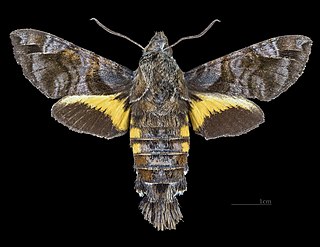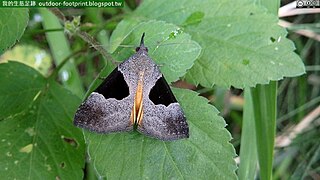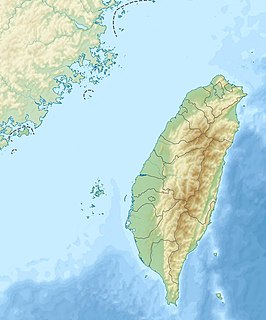The Berbera gerbil is distributed mainly in Somalia, but its range may extend into Ethiopia and Djibouti. It is endemic to the Ethiopian xeric grasslands and shrublands ecoregion.
The Caparaó hocicudo is a rodent species from South America. It is endemic to Brazil where it is found in the Pico da Bandeira mountain range.
The inland forest bat is a vespertilionid bat that occurs in central and arid regions in Australia. They were first described in 1987, published in a review of poorly surveyed microbat populations. A tiny flying mammal, whose body is around twelve millimetres (½ inch) long, that occupies small cavities in trees and buildings while roosting. The nocturnal activity is foraging for insects, typically moths.
The dark bolo mouse or dark-furred akodont is a species of rodent in the family Cricetidae. There are two subspecies; one is found in eastern and central parts of Buenos Aires Province, Argentina, and the other in coastal areas of southern Uruguay.
The Mount Oku hylomyscus is a species of rodent in the family Muridae. Found only on Mount Oku, Cameroon, in tropical Central Africa, its natural habitat is tropical moist montane forests. It has a very small range and is threatened by habitat destruction, so the International Union for Conservation of Nature has rated its conservation status as being "critically endangered".

Brants's whistling rat or Brants' whistling rat is one of two species of murid rodent in the genus Parotomys. It is found in Botswana, Namibia, and South Africa where its natural habitats are subtropical or tropical dry shrubland and pastureland. It was first described in 1834 by the Scottish zoologist Andrew Smith who named it in honour of the Dutch zoologist and author Anton Brants.

The grey-headed honeyeater is a species of bird in the family Meliphagidae. It is endemic to Australia.

The dusky bushbaby is a species of primate in the family Galagidae. It is also known as Matschie's galago, in honour of the German zoologist Paul Matschie, curator of mammals at the Museum für Naturkunde in Berlin. Native to tropical Central Africa, it is found in forests in Burundi, Rwanda, Democratic Republic of the Congo and Uganda. The species is small with a long tail, and has an arboreal, nocturnal and omnivorous lifestyle.

The Lady Burton's rope squirrel is a species of rodent in the family Sciuridae. It is found in Cameroon, Central African Republic, Republic of the Congo, Equatorial Guinea, and Gabon. Its natural habitats are tropical and subtropical moist broadleaf forests and subtropical or tropical moist montane forest. It is a common species with a wide range, and the International Union for Conservation of Nature has rated it as being of "least concern".

The Asian gray shrew is a species of mammal in the family Soricidae. It is found in Bhutan, Cambodia, China, India, Laos, Malaysia, Myanmar, Nepal, Pakistan, the Philippines, Thailand, and Vietnam. It is one of the commonest species within its range and the International Union for Conservation of Nature has assessed its conservation status as being of "least concern".
Poecilosomella conspicua is a distinctive species of flies belonging to the family Sphaeroceridae. It is only known from the Crocker Range, Sabah in northern Borneo.
Poecilosomella curvipes is a distinctive species of flies belonging to the family Sphaeroceridae. It is only known from Taiwan.

Macroglossum insipida, the hermit hummingbird hawkmoth, is a moth of the family Sphingidae. It was described by Arthur Gardiner Butler in 1875.

Thyas coronata is a species of moth of the family Erebidae first described by Johan Christian Fabricius in 1775. It is found from the Indo-Australian tropics of southern China, Taiwan, Japan, Nepal, India, Sri Lanka to Micronesia and the Society Islands.

Eucalyptus torquata, commonly known as coral gum or Coolgardie gum, is an endemic tree of Western Australia. The species is cultivated for use in gardens and as a street tree.

Temnora crenulata is a moth of the family Sphingidae. It is known from forests from Sierra Leone to Congo, Uganda and western Kenya, with an isolated population in the Usambara Mountains of north-eastern Tanzania.

Ichneutica averilla is a moth of the family Noctuidae. It is endemic to New Zealand. This species is found in the North Island at Mount Taranaki but is widespread throughout the South Island and Stewart Island. It prefers mountainous habitat but can be found down to sea level in the southern parts of the South Island. Adults of the species are on the wing between November and March. Larvae likely exist on a variety of herbaceous plants but have been recorded as feeding on species within the genus Plantago. This species is sometimes confused with I. mutas but can be distinguished from the latter on the basis of forewing colour as well as the absence of or an indistinct antemedian forewing line.

Dichromia orosia, sometimes as Dichromia sagitta, is a moth of the family Erebidae first described by Edward Meyrick in 1913. It is found in Sri Lanka and Australia. The caterpillar is a pest of Marsdenia species, Tylophora asthntatica and Tylophora indica.
Margarinotus taiwanus is a species of clown beetle in the family Histeridae. It is endemic to Taiwan.

Chamaemyia taiwanensis is a species of fly in the family Chamaemyiidae. It is found in Taiwan and is the only known representative of its genus there.












